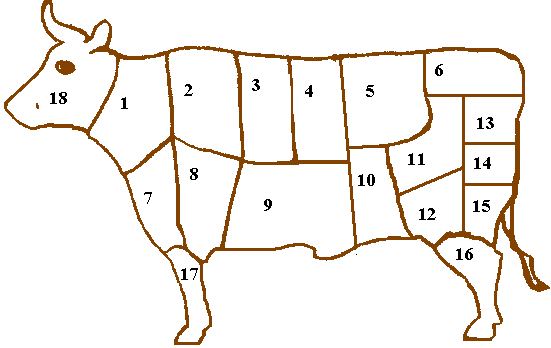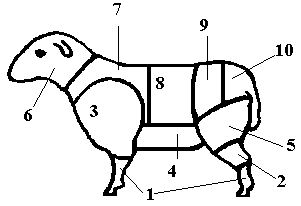

Anyone in the U.K., or North America, who tries to cook from a recipe from the other side of the pond quickly discovers that the truth of the saying that Americans and British are one people divided by a common language. Did you know that an American pint is smaller than a British pint? If you are British, do you have any idea what a scallion is, and if you are American do you know what to use when the British recipe lists treacle?
These tables are intended to help translation of transatlantic cook books. I hope that they will be useful for all English language speaking cooks. I also include information which will help anyone using an old cookbook that does not give modern oven temperature settings and so on. I am English, so I am bound to make mistakes with American English. I hope that North American readers will put me right when I go wrong.
Corrections and additions to the tables will be appreciated and acknowledged. Additions could be words or phrases for which you have a translation, or which you would like me to translate. Please send me an e-mail (see left) if you have a contribution.
My thanks to David Armour in Canada for his help with these tables.
| QUANTITIES | ||
|---|---|---|
| American Standard | Metric | |
| Fluid ounce | 0.0295 litre | |
| Pint | 16 fl oz | 0.473.litre |
| Quart | 2 pints | 0.946 litre |
| Cup | 8 fl oz | 0.236 litre |
| Tablespoon | 3 teaspoons | 15 ml |
| Teaspoon | 5 ml | |
| British Standard | Metric | |
| Fluid ounce | 0.0284 litre | |
| Gill | 5 fluid ounces | 0.142 litre |
| Pint | 20 fl oz | 0.568 litre |
| Cup | 8 fl oz | 0.227 litre |
| Tablespoon | 3 teaspoons | 18ml |
| Dessertspoon | 2 teaspoons (approx.) | 10/12ml (approx.) |
| Teaspoon | 6ml | |
| OVEN TEMPERATURES | |||||
|---|---|---|---|---|---|
| Gas Mark |  | ºF |  | ºC | |
| Very slow | 1 | 275 | 140 | ||
| Slow | 2 | 300 | 150 | ||
| Warm | 3 | 325 | 170 | ||
| Moderate | 4 | 350 | 180 | ||
| Fairly hot | 5 | 375 | 190 | ||
| Hot | 6 | 400 | 200 | ||
| Hot | 7 | 425 | 220 | ||
| Very hot | 8 | 450 | 230 | ||
| Very hot | 9 | 475 | 240 | ||
| WEIGHTS | ||||
|---|---|---|---|---|
| ½ oz | 10 g | 7 oz | 200 g | |
| ¾ oz | 20 g | 8 oz | 225 g | |
| 1 oz | 25 g | 9 oz | 250 g | |
| 1½ oz | 40 g | 10 oz | 275 g | |
| 2 oz | 50 g | 12 oz | 350 g | |
| 2½ oz | 60 g | 1 lb. | 450 g | |
| 3 oz | 75 g | 1½ lb | 700 g | |
| 4 oz | 110 g | 2 lb | 900 g | |
| 5 oz | 150 g | 3 lb | 1.35 kg | |
| 6 oz | 175 g |
| AMERICAN CUPS as WEIGHTS | |||||
|---|---|---|---|---|---|
| 8 American Tablespoons (1 Stick) |  | 4 oz |  | 110 g | |
| 1 American Cup | 5 oz | 150 g | |||
| 1 American Cup | 8 oz | 225 g | |||
Some of the fish eaten in Europe and North America are the same, but many are different. When the fish is the same we call it by the same name. If you are British using an American cookbook, what you need is a list of European fish that can be used as substitutes for the American fish in the recipes (and the same applies vice versa). This is supplied by Rick Stein in his book 'The Taste of the Sea' (see the booklist).
What North Americans call shrimp, the British call prawns. British shrimp are really tiny, and are usually served as 'potted shrimp', in solidified clarified butter. British crayfish are also much smaller than the North American variety.
| BEEF | |||
|---|---|---|---|
| The table is in three parts. First, a diagram showing where the cuts of beef come from and their most common English language names. Second, a few terms I could not include in the diagram. Third, an explanation of the most commonly used French words. | |||
 | |||
| You can select a number on the diagram for a quick link to the key below. | |||
| 1. Neck or Sticking Piece. | 2. Fore Ribs. | ||
| 3. Middle Ribs | 4. Chuck Ribs | ||
| 5. Sirloin. The finest part = Chump End of Sirloin. which contains Fillet Steak. Two sirloins cut together (i.e. both halves of the carcass) = Baron of Beef. T-Bone Steak = a steak on the bone cut from the sirloin or ribs. | |||
| 6. Rump. Upper part = Chump End. Lower part = Silverside, Buttock, or Round. | |||
| 7. Clod or Gullet. | |||
| 8. 2 cuts: (a.) Brisket; (b.) Shoulder or Leg of Mutton Piece or Chuck or Blade Steak. | |||
| 9. Holes. | 10. Thin Flank. | ||
| 11. Topside. | |||
| 12. Thick Flank or Round or Flesh End, or Bedpiece. | |||
| 13. Aitchbone. | 14. Mouse Buttock. | ||
| 15. Veiny Piece. | 16. Leg or Shin. | ||
| 17. Hough or Shin. | 18. Head including Cheek. | ||
| Not on diagram: | |||
| |||
| |||
| Ground Round (American) = Minced Beef (British). | |||
| | |||
| French Cuts: | |||
| |||
| |||
| |||
| |||
| LAMB | |
|---|---|
 | |
| 1 Trotters | 6 Head |
| 2 Shank (Haunch) | 7 Neck* |
| 3 Shoulder | 8 Saddle (two Loins) |
| 4 Breast | 9 Loin - Best End |
| 5 Leg | 10 Loin - Chump End |
| * Divided into Best End and Scrag End. Best End divided into Cutlets (or 'Chops' or 'Single Loin Chops'). One whole Best End is a Rack. | |
| Recipes for 'Mutton' in old cookbooks can be treated as recipes for lamb. Mutton is from an older, tougher animal, but there is no significant difference in cooking times. | |
| PORK |
|---|
| The names of the joints of pork are: |
| Fore-Quarter : |
|
|
|
| Hind-Quarter: |
|
|
|
| POULTRY |
|---|
|
|
|
| VEGETABLES, FRUIT AND NUTS | AMERICAN | BRITISH |
|---|---|
| Beets | Beetroot |
| Low bush blueberry | Bilberry (whinberry) |
| Blueberry | Blueberry |
| Broccoli. Confusion reigns. The British have two vegetables: green sprouting broccoli or calabrese to gardeners, just broccoli to shoppers, and purple sprouting broccoli only known to gardeners. My American cookbooks refer to broccoli, broccoli rab and and broccoletti di rape. | |
| Corn | Sweetcorn (maize) |
| Eggplant (aubergine) | Aubergine (eggplant) |
| Escarole | Curly endive |
| Pine Nuts | Pine Kernels |
| Pole beans (green beans or snap beans) | French beans |
| Radicchio | Red chicory |
| Rucola | Salad rocket |
| Scallions | Spring onions |
| Snow peas | Mange-tout |
| Sunchokes | Jerusalem Artichokes |
| String beans (scarlet runners) | Runner beans |
| Sweet potatoes | Sweet potatoes (yams) |
| Zucchini | Courgettes (baby marrow) |
| PULSES |
|---|
| BEANS |
| The following are all varieties of Kidney Bean:
|
| Fava Beans (American)= Broad Beans (British) |
| Lima Beans (American) = Butter Beans (British). |
| PEAS |
| The following are varieties of dried field peas (not garden peas):
|
| BROWN SUGAR |
|---|
| From darkest to lightest: |
| Muscovado (Br.) or Sugar in the Raw (Am.) |
| Dark Brown |
| Barbados |
| Light Brown |
| Demerara |
| Brownulated (Am.) |
| SYRUP | |
|---|---|
| BRITISH | AMERICAN |
| Treacle | Blackstrap Molasses |
| Golden Syrup | A pale yellow cane sugar syrup. |
| Substitute glucose or honey. | |
| FLOUR | |
|---|---|
| American flour is harder than British flour, i.e. more suitable for bread making. Some American yeast recipes suggest you can use 'plain' or 'all purpose' flour. In Britain you should substitute a 'strong' or 'bread' flour. | |
| BRITISH | AMERICAN |
| Self-Raising Flour | Self Rising Flour |
| Wholemeal Flour | Whole Wheat Flour |
| CREAM | |
|---|---|
| TYPE | FAT CONTENT |
| Jersey (British) | 60% |
| Double (British) | 48% |
| Heavy (American) | 40% |
| Whipping | 30-60% |
| Single (British)or Light or Table (American) | 18% |
| Half and Half (American) | 10-18% |
| Half Cream (British) | 12% |
| CAKE TINS |
|---|
| British cakes rarely have a hole in the middle. American cakes often do, and require special tins. This is a list of tins with holes in the middle! |
|
|
|
|
|
|
| In Britain it is difficult to obtain most of the above tins. If you are in Britain and you want to make pound cake use the deepest widest Savarin tin you can find. |
| Two Cake Tins used in Britain: |
|
| MISCELLANEOUS | |
|---|---|
| AMERICAN | BRITISH |
| Baking Soda | Bicarbonate of Soda |
| Cornstarch | Cornflour |
| Graham Crackers | Digestive Biscuits (the nearest equivalent) |
| Semisweet Chocolate* | Plain Chocolate |
| Strudel Leaves | Filo Pastry |
| Yellow Raisins | Sultanas** |
| *American Cooking Chocolate is unsweetened. This is difficult to obtain in Britain. I have had good results with American cake recipes using plain chocolate, reducing the sugar in the recipe by a little and adding some extra cocoa powder dissolved in a little hot water. | |
| **If a British recipe lists raisins it means black raisins. | |
| |